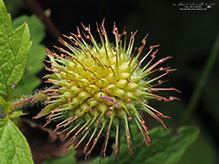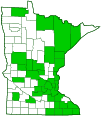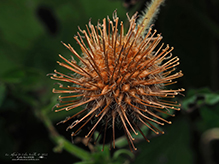rough avens
(Geum laciniatum)
Conservation • Wetland • Description • Habitat • Ecology • Use • Distribution • Taxonomy
Description |
Rough avens is a perennial herbaceous plant. It occurs in the United States from Maine to northern Virginia, west to Minnesota and eastern Kansas, and south along the Appalachian Mountains to northern Georgia. It occurs in southern Canada from Nova Scotia to Ontario. Rough avens is found in bottomland forests, wet prairies, sedge meadows, thickets, fens, and marshes. It is also found in moist depressions of upland prairies, in ditches, on roadsides, at the edges of streams, and at the margins of sloughs. It grows in moist areas under partial sun in loamy or sandy loamy soil. Rough avens is a 16″ to 40″ (40 to 100 cm) tall, erect forb that rises on one or more stems from fibrous roots and either a short, stout, erect, thickening of the base of the stem (caudex) or an underground stem (rhizome). The stem is erect, slender, round, light green, and occasionally branched. The entire stem is moderately to densely covered with spreading to somewhat downward-pointing hairs. Basal leaves are large, 6″ to 12½″ (15 to 32 cm) in outline, and they are on long leaf stalks (petioles). The first basal leaves to appear are not divided (simple), and they are not lobed. Subsequent basal leaves are progressively more lobed and pinnately divided (compound). Divided leaves have usually 3 to 7 major leaflets alternating with up to 10 minor leaflets. The terminal leaflet is larger, sometimes much larger, than the lateral leaflets. Stem leaves are alternate and 1⅜″ to 7″ (3.5 to 18 cm) in outline. They may be pinnately compound with several leaflets, have just three leaflets, or be simple and unlobed. The lower leaves are on long petioles. At the base of each compound leaf there is a pair of leaf-like appendages (stipules). The stipules are broadly egg-shaped or oblong egg-shaped, ¼″ to ⅝″ (7 to 15 mm) long, and often lobed. The leaves become smaller, less divided, and on shorter petioles as they ascend the stem. The uppermost leaves are simple, unlobed, and stalkless. The primary leaflets are 1″ to 4″ (2.5 to 10 cm) long, broadly egg shaped, nearly circular, or diamond shaped (rhombic) in outline. They are often shallowly or deeply cut into 3 or more lobes. The upper and lower surfaces are sparsely to moderately hairy. The inflorescence is a single flower or 2 to 3 flowers at the end of the stem and each branch, and sometimes also single flowers rising from upper leaf axils. Each flower is on a stalk (pedicel) that is densely and conspicuously covered with spreading to somewhat downward-pointing hairs. The flowers are about ½″ (12 mm) wide. There are 5 sepals, 5 petals, numerous stamens, and numerous styles. The sepals are green, triangular egg-shaped, and ⅛″ to ⅜″ (4 to 10 mm) long. They alternate with much smaller, 1⁄32″ to 1⁄16″ (1 to 2 mm) long bractlets. They are spreading at first, but soon bend backwards. The petals are white, spreading, oblong to elliptic, and ⅛″ to 3 ⁄16″ (3 to 5 mm) long. They are shorter than the sepals. There is a raised structure (hypanthium) in the center of the flower. The stamens are arranged in a ring at the base of the hypanthium. The stamens are shorter than the petals, their stalks (filaments) are white, and their anthers are yellow. The infructescence is a bristly, spherical, ½″ to ¾″ (12 to 20 mm) in diameter cluster of numerous seed capsules (achenes). It is green at first, eventually turning brown. The sepals persist in fruit and are bent backwards. The bristles are the styles that have persisted in fruit. They are ⅛″ to ¼″ (4 to 6 mm) long and they are hooked at the tip. The hooked tip is a short terminal segment that eventually falls off. The entire fruiting head will pop off and disperse as a unit, clinging to the fur of a passing animal or the leg of a passing hiker. Among members of the genus, this feature is unique to Geum laciniatum. |
Height |
16″ to 40″ (40 to 100 cm) |
Flower Color |
White |
Similar Species |
Habitat |
Moist to moderately moist. Bottomland forests, wet prairies, sedge meadows, thickets, fens, marshes,moist depressions of upland prairies, ditches, roadsides, edges of streams, and margins of sloughs. Partial sun. Loamy or sandy loamy soil. |
Ecology |
Flowering |
May and June |
Pests and Diseases |
|
Use |
|
Distribution |
||
|
Sources |
|
| 6/2/2024 | ||
Nativity |
||
Native |
||
Occurrence |
||
Common |
||
Taxonomy |
|
Kingdom |
|
| Division |
Tracheophyta (Vascular Plants) |
Subdivision |
Spermatophytina (Seed Plants) |
Class |
|
Order |
Rosales (Roses, Elms, Figs, and Allies) |
Family |
Rosaceae (Rose) |
Subfamily |
Rosoideae (Brambles, Roses, Strawberries, and Allies) |
Tribe |
Colurieae (avens) |
Genus |
Geum (avens) |
Subordinate Taxa |
|
A variety with sparse or no bristles at the tips of the fruits has been described as Geum laciniatum var. trichocarpum. Steyermark’s Flora of Missouri (Yatskievych, 2013) suggests that such a minor variation “seems unworthy of taxonomic recognition.” Flora of North America contends that the difference has little geographical significance, and is not correlated with any other differences. “It appears to be a trivial variation.” Many sources recognize the variety, but just as many do not. Vascular Plants of Minnesota (Ownbey and Morley, 1991) shows var. trichocarpum as the only variety occurring in Minnesota. |
|
rough avens (Geum laciniatum var. laciniatum) rough avens (Geum laciniatum var. trichocarpum) |
|
Synonyms |
|
|
|
Common Names |
|
rough avens |
|
Glossary
Achene
A dry, one-chambered, single-seeded seed capsule, formed from a single carpel, with the seed attached to the membranous outer layer (wall) only by the seed stalk; the wall, formed entirely from the wall of the superior ovary, does not split open at maturity, but relies on decay or predation to release the contents.
Bractlet
A small, often secondary bract within an inflorescence; a bract that is borne on a petiole instead of subtending it; bracteole.
Caudex
A short, thickened, woody, persistent enlargement of the stem, at or below ground level, used for water storage.
Filament
On plants: The thread-like stalk of a stamen which supports the anther. On Lepidoptera: One of a pair of long, thin, fleshy extensions extending from the thorax, and sometimes also from the abdomen, of a caterpillar.
Hypanthium
A cup-like tubular structure of a flower formed from the fused bases of sepals, petals, and stamens, that surrounds the pistil. Its presence is diagnostic of many families, including Rosaceae, Ribes, and Fabaceae.
Pedicel
On plants: the stalk of a single flower in a cluster of flowers. On insects: the second segment of the antennae. On Hymenoptera and Araneae: the narrow stalk connecting the thorax to the abdomen: the preferred term is petiole.
Petiole
On plants: The stalk of a leaf blade or a compound leaf that attaches it to the stem. On ants and wasps: The constricted first one or two segments of the rear part of the body.
Pinnate
Having the leaflets of a compound leaf arranged on opposite sides of a common stalk.
Rhizome
A horizontal, usually underground stem. It serves as a reproductive structure, producing roots below and shoots above at the nodes.
Sepal
An outer floral leaf, usually green but sometimes colored, at the base of a flower.
Stipule
A small, leaf-like, scale-like, glandular, or rarely spiny appendage found at the base of a leaf stalk, usually occurring in pairs and usually dropping soon.
Visitor Photos |
||
Share your photo of this plant. |
||
This button not working for you? |
||
Alfredo Colon |
||
 |
||
MinnesotaSeasons.com Photos |
||
|
||
|
||

Visitor Videos |
||
Share your video of this plant. |
||
This button not working for you? |
||
|
Other Videos |
||
|

|
Created: Last Updated: © MinnesotaSeasons.com. All rights reserved. |






